Introduction
From email and SMS to direct mail and social media: today’s customers, and therefore marketers, use multitudes of engagement channels, with new channels constantly emerging. Customers expect a seamless experience across every channel. To achieve that, however, engagement channels need to be synchronized in a cross-channel approach. Cross-channel marketing has been a “Holy Grail” for marketers for some years now, however, a lot of companies still struggle to achieve it. Here’s an overview of what cross-channel looks like, why it’s important to deliver, and how to overcome the difficulties it presents.
The Difference Between Cross-Channel and Multi-Channel
Cross-channel marketing creates seamless customer experiences across channels. It’s an upgrade over multi-channel marketing, which creates splintered customer experiences across channels.
In general, customers can be communicated with via email, direct mail, push notification, SMS, on-site personalization, offline touchpoints, and more – or any combination of those channels. Marketers employing a multi-channel marketing approach communicate with customers through different channels while treating each channel as a separate entity: Each channel has its own separate ROI analysis and potentially even its own marketing team. Separate communications via different channels don’t take communications via other channels into account.
That can cause contradictions between messages. Take an example of a customer who has complained via an email, who then receives an automated email back that acknowledges their complaint and says that a response will be with them shortly. Hours later, this same customer receives a push notification asking the customer to positively rate the product or service on the app store. In this multi-channel example, the push notification was set to go out at that time, and the emailed complaint did not affect whether or not it was sent. This example could result in a negative response from the customer, as they won’t want to positively rate a company they have just complained to. The customer is not treated as a single person, rather, the customer is treated as a separate person in email communication (where an apology was sent) and push notification (where a rating request was sent).
A customer’s complaint is one of many possible touchpoints across channels. As in the above example, we can say a customer has made a complaint via email, and then receives an automated response. As soon as the complaint is automatically registered, any messages set to be sent to the customer via any channels are automatically put on hold. After the complaint is resolved, a promotional offer can be set to be sent via, for example, the direct mail channel after a set amount of time as a show of gratitude for the customers’ loyalty. The customer journey takes the customer from a negative feeling to a well-presented, well-timed promotional offer that they are happy to accept. That’s possible because the customer is seen and communicated with as the same person across each channel, meaning messages should not contradict others sent through different channels, but rather build on them.
For an inspiring cross-channel case study, check out HelloFresh’s cross-channel success story.
Why Is Cross-Channel Important?
Cross-channel marketing greatly assists customer retention, which is a major point of focus for most businesses. Studies have shown that a five percent increase in retention increases profits by 25-95%.
Today’s customers, however, expect customer relationship management (CRM) that lives up to the cross-channel marketing of large platforms such as Amazon. Large platform marketing has raised customer expectations with dynamic personalization for each individual customer.
Furthermore, each company’s marketing budget needs to be optimally allocated, which a cross-channel approach assists with. When a cross-channel approach is taken, marketers can engage in holistic return-on-investment (ROI) reporting and analysis.
Why is Cross-Channel Hard to Achieve?
Companies that do have multiple channels active, or who are planning on expanding their channel mix, face challenges when synchronizing their channels into a cross-channel framework. Customer data needs to be centralized and made available to each channel with real-time feedback. Marketing teams, meanwhile, need to work together on holistic customer journeys rather than on each channel separately, with a holistic marketing strategy.
Marketers need to overcome:
- A lack of centralized customer profiles
- Struggles to identify customers across channels
- Team silos with no overarching strategy
- Unorchestrated channels
How Do You Do Cross-Channel?
As customer data platform providers, CrossEngage specializes in enabling cross-channel marketing. From our long-standing experience in the field, cross-channel marketing is enabled by more than just technology. We’ve found that strategy, organization, as well as technology all need to be addressed in that order.
Strategy
In splintered multi-channel marketing there are separate strategies and separate KPIs for separate channels, whilst cross-channel marketing demands a holistic customer-centric strategy. Messaging strategies are not created for individual channels, but rather for customer journeys across the channels that they use. Cross-channel marketing strategy needs to be supported by management and then established across departments and teams, including goal and KPI alignment as well as holistic budget allocation.
The strategy itself needs to highlight target groups, the necessary touchpoints and channels for engaging them, and the required data. The strategy should be planned in terms of customer journeys and practical use cases, rather than in terms of separate channels.
Once that’s achieved, organization can be tackled.
Organization
Silos between marketing teams need to be brought down and the teams connected to pursue cross-channel strategy. Traditional marketing teams do not have a role dedicated to the individual customer journey and channel orchestration. That’s best filled by an audience manager (or cross-channel campaign manager), who defines audiences and the respective campaigns across channels while interacting with every involved team, from data management to sales to individual channel teams. Think of the audience manager as the journey planner for the individual customer.
If resources allow for it, having separate audience managers for each phase of the customer lifecycle is ideal as different phases demand different campaigns. Dedicated audience managers can provide special attention to acquisition, onboarding/expansion, and retention/reactivation, whilst communicating with each other to prevent silo effects.
Technology
Strategy and organization must be combined with marketing technology that centralizes customer data, facilitating holistic customer views and marketing approaches. A CDP combines customer data into holistic, detailed, real-time customer profiles. They pull from every connected data source to contain every available form of customer data, from user to transactional to behavioral data, with behavioral data being updated in real-time. Profiles are made instantly available to each of a company’s engagement channel solutions.
Some CDPs, such as CrossEngage, additionally have dedicated cross-channel campaign management features. They allow for a centralized control of connected engagement solutions, enabling marketers to create customer journeys within the single solution.
To read more about CDPs, check out our Beginner’s Guide to CDPs.
Conclusion
The cross-channel marketing approach requires a strategy, organization, and marketing technology overhaul which, when achieved, enables marketers to create personalized customer journeys for each individual customer. The holistic approach greatly assists both customer retention and holistic data analysis.

